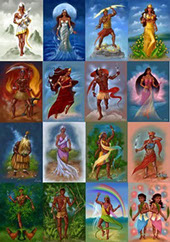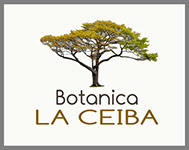About Us
ABOUT THE RELIGION
Most practitioners of Santería prefer the name Regla de Ocha or the Lucumí religion. Although it's practiced today by people all over the world, Regla de Ocha is generally defined as an Afro-Cuban religion that originated in what is today Nigeria and Benin in West Africa. The word Santería comes from Spanish and loosely translates as devotion to the saints, or santos. Many practitioners of the Regla Lucumi refer to the Orichas, or the deities of the religion, as saints or "santos." This tendency to combine terminology and concepts from Catholicism and West African religions is sometimes called religious syncretism.
The Yoruba were a collection of many tribes, often competing for political power, who shared a common religious thread – the worship of Olodumare, and the Orishas. Each Orisha had a center of worship around which their religious services would take place and where his or her priesthood would be initiated and trained. When the Yoruba people were taken from their home lands, people of different tribes were all mixed together, and forced to live and labor together. In a desperate attempt to preserve their traditional religious practices, the Yoruba blended their individual Orisha cults together into one unified religion – the religion of the Lucumí people (La Regla Lucumí). The religion came together on the island of Cuba where it interacted with other African religious practices of the Arará people, the Bantú speaking people, and with Spanish Catholicism. In an effort to reconcile their multi-cultural beliefs, the Lucumí people resorted to syncretism of their orishas with Catholic saints. Thus was born the religion of Santería – a unique blend of traditional Yoruba beliefs colored with the multicultural spiritual beliefs of the island of Cuba.
OUR SERVICES

We will help you find the clarity that you have been seeking for and creating the life you want. We serve our clients, as they find the answers to all of their questions regarding love, relationships, finances and health. We will guide you in creating a more positive and empowering journey filled with endless possibilities.
Our Santos assist and guide us in understanding and guiding you. We will empower you with the tools you need to break old patterns that have kept you stuck, and to support you in finding clarity in matters of the heart and clearing anything that is blocking your well deserved happiness, inner joy and peace of mind. Whatever your dreams are, no matter what challenges you currently face, we will assist you in finding the answers that you need.
OCHA
PALO
SPIRITUAL
Regla de Ocha has a holistic approach, acknowledging the connection with heart, mind, and body. In Santería, the world flows with the primal life energy called aché or growth, the force toward completeness and divinity. Aché is the current that Santería initiates channel so that it empowers them to fulfill their path in life, because aché is connected to all that has life or exhibits power; aché comprises grace, and power. When a person is sick, the healer thinks, interprets and reacts, considering the illness not just a physical dysfunction but also an interface with suffering and bad luck in life, believed to be brought on by the activity of bad spirits.
Palo’s religious function revolves around the prenda or nganga - a magical cauldron composed of different soils, stones, wooden sticks, tools etc.
The Palo priest – called a TATA or YAYA – directs the spirit of the prenda to perform works of magic, to heal, make magical changes happen or to make pacts with new initiates.
Espiritismo is a separate spiritual and religious practice that has was incorporated into Santería in the mid 1900’s.
Many Espiritistas report receiving messages in the form of ideas that pop in your head, or imagery that comes to your mind. Others have feelings in their body, or perceives scents. Allow the information to come to you in whatever way it will.

